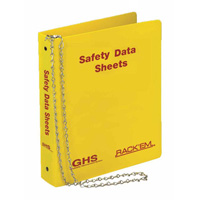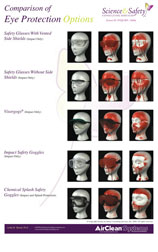



Find all of your laboratory and workplace safety supplies at Safety Emporium!
 Chemical Formula |
 Glossary Index |
 Chronic Effect |
| MSDS Topics |
Free Sites | FAQ's | Regulations | Glossary | Software | Suppliers |
| Books | Forum | Poll | Fun stuff | Quiz | Store | |
| Understand your MSDS with the MS-Demystifier | Search ALL our MSDS info | |||||
CHIP- The Chemical (Hazard Information and Packaging for Supply) Regulations (now obsolete; see below) provided information on hazardous chemicals in Great Britain. These regulations were designed to comply with various European Union (EU) directives relating to the supply of dangerous chemicals.

Get your SDS binders, centers and more from Safety Emporium.
CHIP was amended on a regular basis since it was first adopted as the Chemicals (Hazard Information and Packaging for Supply) Regulations in 1994. Therefore, one may see references to CHIP 96, 98, 99 etc. in older literature. Each new version revoked the previous version. The last version of CHIP was issued in 2009 and was also known as CHIP4.
CHIP4 (2009) broke with previous versions by dropping (Material) Safety Data Sheets (SDS's) compliance which was then addressed through the European REACH regulation.
The remainder of the CHIP regulations were phased out by the European Regulation on Classification, Labelling and Packaging of Substances and Mixtures (known as the CLP Regulation, (EC) No 1272/2008) which is the EU's implementation of the Globally
CHIP4 regulations required the supplier of a dangerous chemical to:
CHIP also defined classes of danger for "substances and preparations dangerous for supply" and used a letter coding system for these classes. You may encounter these symbols on outdated European MSDS's. In addition, labels and sheets in the EU carry required risk phrase and safety phrase codes. In our opinion, these coding systems are not only useless, but confusing - why write a crytic code such as "Xn" instead of simply stating "Harmful"? Regardless, here is a summary of the major classification codes that were used:
| Physico-Chemical Properties1 | ||
|---|---|---|
| Code Letter(s) & Meaning |
Danger Symbol | Description |
| E Explosive |
 |
Solid, liquid, pasty or gelatinous substances and preparations which may react exothermically without atmospheric |
| F+ Extremely Flammable |
 |
Liquid substances and preparations having an extremely low flash point and a low boiling point and gaseous substances and preparations which are flammable in contact with air at ambient temperature and pressure. |
| F Highly Flammable |
 |
|
| (none) Flammable |
(no symbol) | Liquid substances and preparations having a low flash point. |
| O Oxidizing |
 |
Substances and preparations which give rise to a highly exothermic reaction in contact with other substances, particularly flammable substances. |
| Health Effects1 Note: Some symbols appear more than once in the following table. Please study the first column carefully.
| ||
| Code Letter(s) & Meaning |
Danger Symbol | Description |
|---|---|---|
| C Corrosive |
 |
Substances and preparations which may, on contact with living tissues, destroy them. |
| N Dangerous For The Environment |
 |
Substances and preparations which, were they to enter into the environment, would present or might present an immediate or delayed danger for one or more components of the environment. Does not apply to preparations. In certain cases, some substances do not need to be labelled with the danger symbol for this category. |
| T+ Very toxic |
 |
Substances and preparations which in very low quantities cause death or acute or chronic damage to health when inhaled, swallowed or absorbed via the skin. |
| T Toxic |
 |
Substances and preparations which in low quantities cause death or acute or chronic damage to health when inhaled, swallowed or absorbed via the skin. |
| Xi Irritant |
 |
Non-corrosive substances and preparations which, through immediate, prolonged or repeated contact with the skin or mucous membrane, may cause inflammation. |
| Xn Harmful |
 |
Substances and preparations which may cause death or acute or chronic damage to health when inhaled, swallowed or absorbed via the skin. |
| Sensitizing
Xn
Xi
|
 (i.e. Xn or Xi) |
Substances and preparations which, if they are inhaled or if they penetrate the skin, are capable of eliciting a reaction by hypersensitization such that on further exposure to the substance or preparation, characteristic adverse effects are produced. |
| Carcinogenic
T - Category 1 1 |
(depends on category) | Substances and preparations which, if they are inhaled or ingested or if they penetrate the skin, may induce cancer or increase its incidence |
| Mutagenic
T - Category 1 1 |
(depends on category) | Substances and preparations which, if they are inhaled or ingested or if they penetrate the skin, may induce inheritable genetic defects or increase their incidence. |
| Toxic for reproduction
T - Category 1 1 |
(depends on category) | Substances and preparations which, if they are inhaled or ingested or if they penetrate the skin, may produce or increase the incidence of non-inheritable adverse effects in the progeny and/or of male or female reproductive functions or capacity. |
1 See CHIP4 Schedule 1 for the formal classification/categorization system.
NOTE: We may collect a share of sales or other compensation from the links in the following list:

Ensure workers understand what eye protection is really all about with safety posters from Safety Emporium.
The now-obsolete CHIP4 (2009) regulations delegated Safety Data Sheet (SDS) compliance to the European REACH regulation. REACH regulations still require an SDS to be provided the first time the chemical is supplied or if the composition of the material changes so that new information has to be included.
If your current SDS is referencing CHIP regulations the sheet is most likely obsolete. Check the date to see if it is most recent version and be sure the content is GHS-compliant.
The now-obsolete CHIP3 (2002) specifically addressed safety data sheets in the following areas:

Safety Emporium has a great lineup of gas cylinder signs, storage racks, clamps and more.
See also: COSHH, HMIS, NFPA, REACH, TSCA, The SDS FAQ entry on European SDS requirements.
Additional definitions from Google and OneLook.
Entry last updated: Sunday, July 3, 2022. This page is copyright 2000-2025 by ILPI. Unauthorized duplication or posting on other web sites is expressly prohibited. Send suggestions, comments, and new entry desires (include the URL if applicable) to us by email.
Disclaimer: The information contained herein is believed to be true and accurate, however ILPI makes no guarantees concerning the veracity of any statement. Use of any information on this page is at the reader's own risk. ILPI strongly encourages the reader to consult the appropriate local, state and federal agencies concerning the matters discussed herein.